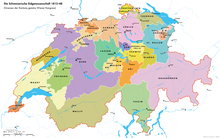Neuchâtel trade
The Neuchâtel trade was a conflict between Switzerland and the King of Prussia Friedrich Wilhelm IV in the years 1856/1857.
prehistory
Since the Congress of Vienna of 1815 that took Principality of Neuchâtel (Neuchâtel) a peculiar double role: on the one hand it belonged to the Swiss Confederation as the Canton on the other hand, it was from 1707 to 1806 and again since 1814 as a sovereign principality with Prussia in personal union connected.
In the revolutionary year of 1848 , the radical democratic Montagnards, who found support in the Swiss Jura in particular, overthrew the conservative government and proclaimed a republic on March 1, 1848.
conflict
In 1856 the royalists took advantage of the differences that had arisen in the Radical Party, which had ruled up to that point, and an election result that they considered favorable. They carried out a counter-revolutionary coup that was crushed by Neuchâtel and federal troops. Several hundred royalists were captured and threatened with the death penalty .
The King of Prussia then demanded the release of the rebels and threatened military measures. After the federal government had refused an amnesty for the royalists, Prussia and Switzerland prepared for war. Switzerland mobilized around 20,000 men in December 1856, while Prussia did not begin mobilizing until January. On December 13, 1856, Prussia broke off diplomatic relations with Switzerland and ordered a mobilization . On December 27, 1856, the Swiss Parliament elected General Guillaume-Henri Dufour as Commander-in-Chief of the Army. Friedrich Frey-Herosé figured as chief of staff and General Dufour elected Johann Friedrich Frey von Brugg as adjutant general of the army . In Basel , with the participation of Gottlieb Ott , an additional bridge, the Dufour Bridge , was built over the Rhine in order to be able to bring Swiss troops across the Rhine more quickly. The Swiss Confederation trusted that a march through the Prussian armies in the Grand Duchy of Baden would meet with considerable resistance from the population, as Prussia had brutally suppressed the imperial constitution campaign here in 1849.
Switzerland expected southern German troops to join the Confederates.
The plan of the Commander-in-Chief, General von der Groeben, was not an approach to Neuchâtel or the occupation of Swiss territory as a bargaining chip, but the smashing of the federal army. To this end, a corps should march against Basel and take Basel as a bridgehead, while the main forces should enclose Schaffhausen and then "advance along the Aare towards Zurich".
Preussen planned to mobilize 130,000 to 140,000 men who would be divided into four corps or eight to nine divisions were set up, which corresponded to half of all Prussian troops. It should v. a. Troops are deployed who were equipped with the needle gun or the Minié rifle (muzzle loader with Minié bullet ).
The Prussian troops were to be transported to the border by rail. At that time, hunter battalions were considered to be the strongest troops. Only 9 cavalry regiments were planned, as it was expected that there would be little opportunity for the use of cavalry. On the other hand, they wanted to use "numerous artillery". The cost of the campaign was estimated at 15 to 30 million, for which the state took out loans, whereby it was noted in the press that these costs were high considering the fact that Neuchâtel recently delivered only 60,000 per year to the Prussian king would have.
Switzerland planned to mobilize 200,000 to 230,000 men. The aim was to fight the battle north of the Rhine in order to protect the Swiss population and infrastructure. The motivation of the troops and the population was great. The costs on the Swiss side were estimated at 30 million. On the Swiss side, v. a. mentioned the sniper battalione. The equipment and attitude of the Swiss troops were described as good, while the Swiss officers were accused of lack of experience by the German press.
Since the other major European powers were not prepared to support the Prussian king's claim to the restoration of the Ancien Régime , the latter was forced to renounce all rights over Neuchâtel in the Paris Treaty of 1857 . But he kept the title of Prince of Neuchâtel. In return, the Swiss released all royalists. This also ended the 150 years of Prussian rule in Neuchâtel, which lasted for 150 years and was only briefly interrupted between 1806 and 1814, even if it had in fact already been ended by the proclamation of the republic in 1848.
See also
literature
- Roland Beck : Roulez tambours. Politico-military aspects of the Neuchâtel conflict between Prussia and Switzerland 1856/57 (= ASMZ series ). Edited by ASMZ, Huber, Frauenfeld 1982, ISBN 3-274-00004-3 .
- Edgar Bonjour : The Neuchâtel conflict 1856/57. Investigations and documents. Helbing & Lichtenhahn, Basel et al. 1957.
- Hans-Dierk Fricke: The Neuchâtel conflict 1856/1857 in the mirror of the German press. 2010, PhD at the Fernuniversität Hagen
- Rita Stöckli: Neuchâtel trade. In: Historical Lexicon of Switzerland .
Individual evidence
- ↑ Hirtenfeld, J. Military newspaper. Tenth year. 1857. Vienna: Print by M. Auer, 1857, 87.
- ^ Hans-Dierk Fricke: The Neuchâtel conflict 1856/1857 in the mirror of the contemporary German press. 2010
- ^ Hans-Dierk Fricke: The Neuchâtel conflict 1856/1857 in the mirror of the contemporary German press. 2010, p. 110
- ^ Hans-Dierk Fricke: The Neuchâtel conflict 1856/1857 in the mirror of the contemporary German press. 2010, p. 316.
- ^ Hans-Dierk Fricke: The Neuchâtel conflict 1856/1857 in the mirror of the contemporary German press. 2010, pp. 321-333
- ^ Hans-Dierk Fricke: The Neuchâtel conflict 1856/1857 in the mirror of the contemporary German press. 2010

